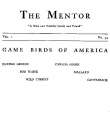You are here
قراءة كتاب The Mentor: Game Birds of America, Vol. 1, Num. 34, Serial No. 34
تنويه: تعرض هنا نبذة من اول ١٠ صفحات فقط من الكتاب الالكتروني، لقراءة الكتاب كاملا اضغط على الزر “اشتر الآن"

The Mentor: Game Birds of America, Vol. 1, Num. 34, Serial No. 34
ones dive and swim away, more under water than above it, and, leaving the slough, crawl through the grass to the next refuge, hiding there safely until all danger is passed. Inherited experience has taught them the way of life, that their species may be perpetuated.
THE CANVASBACK

BLACK DUCKS
These birds were purposely flushed and taken on the first upward spring.
Long live the canvasback! His fame has gone farther, perhaps, than that of any other American game bird. Some epicures rank him above the little-neck, the lobster, or the terrapin, and he is considered a greater luxury than quail on toast. Yet the canvasback, when deprived of its favorite food, the wild celery, is hardly superior to the despised mud-hen. Wilson tells us that many years ago a vessel loaded with wheat was wrecked near Great Egg Harbor. The wheat floated out in quantities, and soon the bay was “covered” with a new kind of duck unknown to the local gunners. They had great sport for three weeks, shooting canvasbacks, and sold them for twenty-five cents a pair; but did not discover the particular excellence of their flesh. They finally learned what they were and that they might have disposed of them for four times the sum they had received.
Redheads, which feed to a great extent on wild celery, often appear on the table masquerading as canvasbacks. In one case, at least, the gunner sold to some innocent clerks a lot of fish-eating sheldrakes or mergansers under the name of canvasbacks. I am told that the dishes that resulted were about as palatable as a bundle of old stewed kerosene lampwicks.
No longer ago than 1850 canvasbacks hovered in interminable flocks about Chesapeake Bay. Over ten thousand people were accustomed to shoot there. These ducks were then plentiful in all first class restaurants and hotels of the East. The glories of Chesapeake Bay as a shooting ground have largely departed, and canvasback ducks are now rarely seen on tables where they formerly appeared often; but there is still a stock of breeding birds left, and with adequate protection it will be long before we see the last of the species. So far as I know, no one has as yet succeeded in breeding this bird in captivity. Therefore we cannot depend on artificial propagation; but must protect the stock of wild birds.

DUCKS SWIMMING ACROSS A BAY
SUPPLEMENTARY READING—Wild Fowl of North America, and North American Shore Birds, by Daniel Giraud Elliot; Feathered Game of the Northeast, by Walter H. Rich; American Game Bird Shooting, by George Bird Grinnell.
THE MENTOR
ISSUED SEMI-MONTHLY BY
The Mentor Association, Inc.
381 Fourth Ave., New York, N. Y.
Vol. 1 No. 34
ANNUAL SUBSCRIPTION, FOUR DOLLARS. SINGLE COPIES TWENTY CENTS, FOREIGN POSTAGE, SEVENTY-FIVE CENTS EXTRA. CANADIAN POSTAGE, FIFTY CENTS EXTRA. ENTERED AT THE POST OFFICE AT NEW YORK, N. Y., AS SECOND-CLASS MATTER.
Editorial
The legend of The Mentor must by this time have become familiar to all readers. It is printed on the cover, “A Wise and Faithful Guide and Friend.” We have been asked the origin of this. The phrase is quoted exactly from the definition of MENTOR as given by one of the highest authorities in the English language. We are glad that some one asked this. It is the sort of inquiry that makes our mail


